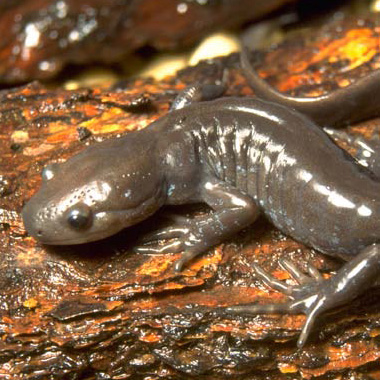Jefferson Salamander

Species description
Jefferson Salamander (Ambystoma jeffersonianum) is a long lived and relatively large salamander which may live up to 30 years and grow 12-20 centimetres in length. It has a grey or brown coloured back, with lighter underparts and may have blue flecks on its sides and limbs. Young Jefferson Salamanders (larvae) look like miniature adults, but with external gills. The species is found only in North America, with Ontario being the northern limit of its range.
In Canada, Jefferson Salamander is found only in southern Ontario, mainly along the Niagara Escarpment. A total of 45 populations have been documented in the province. Adult Jefferson Salamanders spend most of their lives in deciduous or mixed-wood forests. A map of the provincial distribution of Jefferson Salamander is available on the Government of Ontario’s species at risk website.
In the winter, individuals reside in deep cracks in rock or in rodent burrows that extend below the frost line. Come spring, adult Jefferson Salamanders are often required to travel through a variety of habitat types and across roads to locate woodland ponds in which they breed and lay their eggs. Adults then head into the surrounding forest for the summer and fall, typically living under logs or rocks, in leaf litter, or in soil that is moist and loose. After hatching, the young live underwater until they lose their gills in midsummer and then move into nearby forest.
Major threats to the survival and recovery of Jefferson Salamander include habitat loss and degradation, fragmentation of woodlands and breeding ponds, road-related threats (e.g., vehicles and pollutants) and introduction of carnivorous fish to breeding ponds, which can prey upon the egg, juvenile and adult stages of the species.
The survival and recovery of Jefferson Salamander is also influenced by other factors. In particular, the specific habitat requirements of Jefferson Salamander mean that suitable habitat for the species is often limited. For breeding, the species requires woodland ponds that lack fish (while providing adequate amounts of food and sites for egg attachment), but many forested wetlands are connected to streams, through which fish can gain access to breeding ponds. As well, populations of Jefferson Salamander can be affected by ponds freezing or drying during breeding or development of the young. Importantly, the terrestrial habitat must have appropriate features to support feeding, moisture retention and predator avoidance.
Jefferson Salamander is listed as endangered at the provincial level (Species at Risk in Ontario List) and is listed as threatened at the federal level (Schedule 1 under the Species at Risk Act). Globally, the species is ranked as apparently secure, as it is considered uncommon but is not rare throughout its entire range as a whole.
Provincial status
Prior to the Endangered Species Act, 2007 (ESA or “the Act”), the Committee on the Status of Species at Risk in Ontario (COSSARO) assessed Jefferson Salamander as threatened. The species was listed as threatened in 2004 and retained this status when the Act came into force in 2008. In 2011, COSSARO reassessed the status of Jefferson Salamander and, in that same year, its listing was changed from threatened to endangered on the Species at Risk in Ontario List. In future assessments, COSSARO may consider information regarding the species’ threats and trends in population and distribution gained through protection and recovery actions.
Species and habitat protection
All Jefferson Salamanders have been protected from being killed, harmed, harassed, captured or taken since the ESA came into force in 2008.
In addition, the habitat of Jefferson Salamander has been protected from being damaged or destroyed since 2010, when the government developed a habitat regulation for the species.
Protecting Jefferson Salamander and enforcing the regulation protecting the specific habitat of the species are key components in the implementation of the ESA and continue to be government-led actions, as identified in the government response statement. As a previously threatened and now endangered species, Jefferson Salamander has been protected from being killed, harmed, harassed, captured or taken since the ESA came into force in 2008. In addition, the habitat of Jefferson Salamander is protected from being damaged or destroyed; habitat protection has been in place since 2010 when the government completed a habitat regulation for the species. Prior to its transition to the ESA, there was no species or habitat protection for Jefferson Salamander. Further information on species and habitat protection is provided in section 2.3 of the introductory chapter of this document.
Although the ESA does not require a habitat regulation to be developed for transition species
Any person who negatively impacts Jefferson Salamander or its habitat without prior authorization may be prosecuted under the ESA.
Recovery strategy
A recovery strategy for Jefferson Salamander was completed on February 18, 2010, which was in advance of the date required by the ESA. It represents best science advice to government. The strategy identified the habitat needs of Jefferson Salamander and the threats that it faces, while recommending objectives and approaches for protecting and recovering the species. The recovery strategy also included recommendations on the areas of habitat to be considered in the development of a habitat regulation.
Government response statement
The Ministry of Natural Resources and Forestry (“the Ministry”) published the government response statement (GRS) for Jefferson Salamander on November 18, 2010, which was within the time frame required by the ESA. The GRS is government policy that contains the Government of Ontario’s goal for the recovery of Jefferson Salamander.
Recovery goal
The government's goal for the recovery of Jefferson Salamander is to ensure that threats to populations and habitat are addressed, in order to allow for the long-term persistence and expansion of the species within its existing Ontario range.
To help achieve this goal, the government leads and supports a number of recovery actions. Common actions for the government to lead as it works towards achieving a species’ recovery goal are provided in section 2.5 of the introductory chapter of this document. A specific action for the government to lead to help protect and recover Jefferson Salamander is:
- Ensure appropriate timing windows for activities undertaken in and around Jefferson Salamander habitat are considered in the application of the ESA.
The GRS for Jefferson Salamander outlines 10 actions in which the Ministry is using a variety of methods to support others to undertake. These government-supported actions fall under the four objectives identified in the GRS, which are:
- Identify and monitor populations of the Jefferson Salamander in Ontario;
- Evaluate and implement threat mitigation and habitat restoration techniques;
- Address knowledge gaps on the species’ movements and habitat use to inform protection of habitat; and
- Raise awareness and promote stewardship of Jefferson Salamanders and their habitat in Ontario.
The subsequent sections of this chapter provide a review of actions that the government has led or supported to help achieve the recovery goal for Jefferson Salamander.
Government funded projects
An important government-led action in the GRS for Jefferson Salamander is to support partners to undertake activities to protect and recover the species. Through the Species at Risk Stewardship Fund the Ministry has supported a total of 40 projects designed to contribute to the protection and recovery of Jefferson Salamander. Three of these projects ($42,999) focused exclusively on the species, while the other 37 projects ($1,438,056) focused on multiple species at risk, including Jefferson Salamander. In addition to the support provided through the Species at Risk Stewardship Fund, partners focusing exclusively on Jefferson Salamander reported that they were successful in securing additional funding and in-kind support ($31,975) from other sources, as did partners with projects designed to benefit multiple species at risk, including Jefferson Salamander ($2,425,924). These values for additional funding and in-kind support include the estimated values of the time and expertise provided by volunteers, which are outlined below.
Stewardship partners reported that the province’s funding support helped them to involve 13 individuals who volunteered 136 hours of their time toward protection and recovery activities that focused exclusively on Jefferson Salamander, which has an estimated value of $3,670. As well, a total of 2,559 individuals volunteered 33,887 hours of their time toward protection and recovery activities for multiple species at risk, including Jefferson Salamander. These voluntary contributions have an estimated value of $825,785.
The Ministry’s stewardship partners reported that through both their efforts and the efforts of their volunteers to implement actions contained in the GRS, they were successful in enhancing 1,113 hectares of habitat expected to benefit multiple species at risk, including Jefferson Salamander. In addition, stewardship partners reported providing outreach on multiple species at risk (including Jefferson Salamander) to 207,303 individuals.
The Ministry also supports proponents in conducting research that addresses important knowledge gaps for species at risk. Through the Species at Risk Research Fund for Ontario, the Ministry provided funding to a partner to conduct research on a new survey technique for Jefferson Salamander.
The remainder of this section highlights three projects that were supported through the Species at Risk Stewardship Fund or the Species at Risk Research Fund for Ontario and their corresponding government-supported recovery actions.
A partner conducted a project in three different years to support a long-term project on the Oak Ridges Moraine. The project has included surveys for Jefferson Salamander (using minnow traps and genetic testing), which identified a new breeding site of the species. The partner also undertook activities to reduce threats to these populations and restore habitat, such as using erosion control measures to decrease siltation of a breeding pond, constructing a boardwalk to prevent damage to pond habitats and identifying road mortality sites for mitigation. In addition, the partner expanded its public tour program, through which 257 students and members of the public were taught about the habitat of Jefferson Salamander and other species at risk from 2009-2011. This project supported several GRS actions, including those focused on documenting the locations of populations, conducting threat mitigation, as well as awareness and promoting stewardship of the species and its habitat.
Work carried out by a partner in the Niagara region provides an additional example of the stewardship projects that have been conducted for Jefferson Salamander. Consistent with the high priority GRS action to document the locations of populations, the partner conducted field surveys for the species and its habitat, which confirmed (through genetic testing) seven occurrences of Jefferson Salamander and a vernal pool breeding site used by the species. The partner used this information to update biological inventories, as well as to install a viewing platform and interpretive signs next to the breeding site to protect it from visitor-related impacts while providing the public with an opportunity to observe and learn about this important habitat. A press release and an article in the partner’s newsletter helped to inform the public about this new educational opportunity. These activities implemented the GRS actions that focus on conducting threat mitigation and raising awareness and promoting stewardship of the species and its habitat.
Through the Species at Risk Research Fund for Ontario a partner developed and tested the effectiveness of a rapid survey protocol that could be used to better understand the distribution and occurrence of Jefferson Salamander across its range in southern Ontario. In particular, the purpose of the project is to assess whether environmental DNA and sequencing can be used to determine if Jefferson Salamander can be detected from water samples collected from within habitats where the species is known to occur. Early testing results indicate that the technique is effective for detecting environmental DNA of Jefferson Salamander and the partner is proceeding to later-stage testing. This project supports development of the GRS action to implement a standardized monitoring protocol to measure the presence or absence of Jefferson Salamander.
Species at Risk Stewardship Fund
-
 $42,999
$42,999for Jefferson Salamander exclusively
-
 $1,438,056
$1,438,056for multi-species projects that included Jefferson Salamander
-
 $2,457,899
$2,457,899in additional funding and in-kind support
-
 40
40projects
-
 2,572
2,572volunteers
-
 34,023
34,023hours
-
 207,303
207,303people received outreach
-
 1,113
1,113hectares of habitat enhanced
Efforts to minimize adverse effects on and create an overall benefit for Jefferson Salamander
Supporting partners to undertake activities to protect and recover Jefferson Salamander, such as through permits and their associated conditions, is an important government-led action identified in the GRS for the species. A total of 60 permits have been issued for Jefferson Salamander since the species has been protected under the ESA. This includes 58 ‘protection and recovery permits’ (i.e., 17(2)(b) permit), of which the majority pertained to Jefferson Salamander exclusively, while five included additional species at risk. ‘Protection and recovery’ permits are issued if the purpose of the activity that they would enable is to assist in the protection or recovery of the species specified in the permit. These permits enabled a variety of organizations to undertake activities such as conducting surveys to verify and document the locations of populations, as well as restoring habitat by reducing erosion, planting natural cover, controlling invasive species and installing a boardwalk and fencing to minimize human interference with the species. In addition, two ‘overall benefit permits’ (i.e., 17(2)(c) permit) have been issued for Jefferson Salamander. Several of the conditions attached to these two permit types implement government-led and government-supported actions identified in the GRS for Jefferson Salamander, including:
- Undertaking construction outside of the spring breeding season to avoid the potential for impacting migrating salamanders;
- Planting suitable trees, shrubs and herbaceous plants to restore foraging habitat and create connected dispersal corridors between existing wooded areas and other appropriate habitats, including potential breeding ponds, which will facilitate interaction between two populations of Jefferson Salamander;
- Increasing community awareness of Jefferson Salamander and discouraging encroachment into regulated habitat by installing signage and developing a stewardship brochure to distribute to local residents; and
- Reporting all observations of Jefferson Salamander to the Ministry.
Other conditions designed to minimize adverse effects included, but are not limited to:
- Requiring installation of adequate erosion and sediment control measures before construction may commence;
- Protecting the habitat of Jefferson Salamander by installing surface water and ground water management systems to maintain existing water flows to breeding ponds;
- Installing permanent fencing and an exclusion wall to prevent Jefferson Salamander from entering residential lots and to limit access by humans and pets to regulated habitat;
- Monitoring Jefferson Salamander use of enhanced/restored habitat areas and the effectiveness of the mitigation measures, which will improve knowledge of effective recovery techniques; and
- Addressing any deficiencies in restored habitat areas and mitigation measures prior to the next Jefferson Salamander migration period.
Further information regarding ‘overall benefit permits’ is available through Ontario’s Environmental Registry.
A total of three agreements were entered into for Jefferson Salamander. These agreements were enabled through Ontario Regulation 242/08 (prior to the July 1, 2013 amendment). Conditions of the agreements involve implementing actions in the mitigation plan, including, but not limited to:
- Minimizing adverse effects (e.g., identifying sensitive time periods for the species based on life history characteristics);
- Monitoring, collecting and maintaining information on the species and the mitigation measures taken; and
- Submitting an annual report summarizing the results and the effectiveness of the work.
Since 2013, two activities that may affect Jefferson Salamander or its habitat have been registered for the purposes of Ontario Regulation 242/08 under the ESA. Both activities are registered under 'Species protection, recovery activities' (section 23.17) of Ontario Regulation 242/08, and include work such as surveys to document the locations of potential populations of Jefferson Salamander. These registrations require the registered individual to comply with all conditions of the regulation, such as:
- Implementing the actions in a mitigation plan developed by an expert on the species to help minimize or avoid any adverse effects;
- Ensuring that any person carrying out any part of the activity receives training on how to identify the species and its habitat, potential threats posed to the species and its habitat by the activity, and the steps that must be taken to minimize any adverse effects;
- Updating mitigation plans every five years to include information obtained while monitoring the effects of the activity;
- Reporting observations of the species to the Ministry using the Rare Species Reporting Form; and
- Preparing a report following completion of the activity that provides a summary of the outcome of the activity, including a detailed assessment of the extent to which the activity achieved its purpose.
-
58protection or recovery permits
-
2overall benefit permits
-
3agreements
-
2registrations
Occurrences of Jefferson Salamander in Ontario
Natural Heritage Information Centre
Forty-five populations
Twenty-four of the 45 populations are historical
Since 2008, when Jefferson Salamander became protected under the ESA, the Ministry has received 262 records of the species. These records are based on observations documented between 1937 and 2014, and have helped to redefine where the species is and was known to occur, and provided additional information on habitat and threats. Although the majority of records submitted did not include genetic testing, there was a subset that did and these helped to identify and determine the current status of eight of the 45 populations where Jefferson Salamander is now considered extant (four populations) or historical (four populations); these eight records are based on observations documented prior to 2008. Encouraging the submission of observations of Jefferson Salamander to the Ministry is included in the GRS as a government-led action.
Everyone is encouraged, or may be required by an authorization or approval, to submit observations of Jefferson Salamander, as well as every other species at risk, to the Ministry’s Natural Heritage Information Centre for incorporation into the provincial record of observations.
-
262observations of the species were submitted to the NHIC since 2008
Summary of progress towards meeting the recovery goal and recommendations
Summary of progress
Progress has been made toward all government-led actions and several of the government-supported actions outlined in the GRS for Jefferson Salamander. As indicated in this chapter, the Government of Ontario has directly undertaken actions to: ensure appropriate timing windows for activities undertaken in and around Jefferson Salamander habitat are considered; encourage submission of Jefferson Salamander data to the Natural Heritage Information Centre; protect the species through the ESA and its habitat through a habitat regulation; and support partners to undertake activities to protect and recover the species. Additionally, as indicated in the introductory chapter of this document, the government has established and communicated annual priority actions for support (section 3.1); educated other agencies and planning authorities on the requirement to consider the protection of the species and its habitat (sections 3.3 and 4.4); and undertaken communications and outreach to increase public awareness of species at risk in Ontario (section 4.3).
Progress has been made toward most of the government-supported recovery objectives, and several of the associated actions, that are identified in the GRS for Jefferson Salamander.
Under the objective to identify and monitor populations of the species, considerable progress has been made toward the first of the two actions and initial progress has been made toward the second action. The first action has been implemented through numerous projects supported by the Species at Risk Stewardship Fund or through conditions of authorizations, whereas a project undertaken through the Species at Risk Research Fund for Ontario and development of a survey protocol have supported progress toward the second action. The respective actions under this objective are:
- Verify and document the locations of historic, existing and potential populations and the characteristics of their habitat (Action No. 1; High Priority); and
- Implement a standardized monitoring protocol to measure the presence or absence of salamanders, the site-specific and cumulative impacts at the locations, and trends in habitat condition. The monitoring frequency of the locations should be prioritized on the basis of current and potential threats. Each year, monitoring should include both unaltered sites and sites under threat, in order to allow for comparison of impacts (Action No. 2; High Priority).
Under the objective to evaluate and implement threat mitigation and habitat restoration techniques, various projects enabled through the Species at Risk Stewardship Fund and activities enabled through authorizations have supported strong progress on one of the five actions, specifically:
- Where appropriate, implement habitat restoration and threat mitigation techniques at priority sites (Action No. 6).
Under the objective to raise awareness and promote stewardship of Jefferson Salamander and its habitat, substantial progress has been made toward the recovery action. The action was implemented through numerous projects supported by the Species at Risk Stewardship Fund and through a condition of an authorization, and is:
- Develop communication products and tools to provide information to landowners, property managers, industry, local stewardship councils, conservation authorities and other stakeholders to assist in the recovery of the species and promote land stewardship (Action No. 10).
As stated above, the government’s goal for the recovery of Jefferson Salamander is to ensure that threats to populations and habitat are addressed, in order to allow for the longterm persistence and expansion of the species within its existing Ontario range. Several government-led actions address threats to populations and habitat. Partners have also addressed threats to the species by carrying out the government-supported action of implementing habitat restoration and threat mitigation techniques at priority sites. These government-led and government-supported actions have made progress towards meeting the recovery goal, and it continues to be important to mitigate threats to this species. This can be achieved by continuing to implement habitat restoration and threat mitigation, while also carrying out several of the GRS actions for which progress has been limited.
Recommendations
As stated in the GRS, the review of progress towards protecting and recovering Jefferson Salamander can be used to help identify whether adjustments are needed to achieve protection and recovery of the species. Based on progress to-date, the overall direction provided in the GRS for Jefferson Salamander should continue to guide protection and recovery actions for the species, particularly for those actions identified in the GRS as high priority. The following recommendations for the implementation of the GRS are suggested for moving forward with protection and recovery of Jefferson Salamander:
- Actions for which progress has been limited should be supported in future implementation planning, such as investigate the tolerance of the species to stressors and potential approaches to mitigate these threats (Action No. 3; High Priority); at sites where Jefferson Salamander used to occur, identify factors that likely caused the loss of the population (Action No. 4); identify currently unoccupied sites where the species used to occur and where the habitat has the potential to be enhanced or restored (Action No. 5); as opportunities arise, support the securement of habitat of the Jefferson Salamander through existing land securement and stewardship programs (Action No. 7); continue research on the species’ use of habitat with a focus on gaining information about fall movements, overwintering areas and juvenile dispersal (Action No. 8); and conduct research on the hydrology of breeding habitat to determine the sensitivity of breeding habitat to changes in the quantity and quality of water (Action No. 9).
- Although initial progress has been made toward development of the action to implement a standardized monitoring protocol (Action No. 2; High Priority), further work is required to fully implement this action.
Moving forward, protecting and recovering Jefferson Salamander will continue to be a shared responsibility that will require the involvement of many individuals, organizations and communities. Financial support for the implementation of actions may be available through the Species at Risk Stewardship Fund, the Species at Risk Research Fund for Ontario or the Species at Risk Farm Incentive Program. The Ministry can also advise if any authorizations under the ESA or other legislation may be required to undertake a project. By working together, progress can continue to be made towards protecting and recovering Jefferson Salamander in Ontario.
Summary of progress toward the protection and recovery of Jefferson Salamander in Ontario (2007 to 2014)
Provincial status
- Jefferson Salamander has been listed as endangered under the Endangered Species Act, 2007 (ESA) since 2011. Prior to its transition to the ESA, Jefferson Salamander was listed as threatened on the Species at Risk in Ontario List, and retained this status when the ESA came into force. The species has been protected from being killed, harmed, harassed, captured or taken since 2008, and its habitat has been protected from damage or destruction since 2010.
Species-specific documents and guidance published by the government
- Recovery Strategy for the Jefferson Salamander (Ambystoma jeffersonianum) in Ontario (2010)
- Jefferson Salamander: Ontario Government Response Statement (2010)
- Jefferson Salamander Habitat Regulation (Ontario Regulation 242/08; 2010)
Government-supported stewardship projects
- Through the Species at Risk Stewardship Fund the Ministry of Natural Resources and Forestry (“the Ministry”) has enabled its stewardship partners to conduct a total of 40 projects that have supported the protection and recovery of Jefferson Salamander and other species at risk. Three projects ($42,999) focused exclusively on Jefferson Salamander, while the other 37 projects ($1,438,056) focused on multiple species at risk, including Jefferson Salamander.
- The Ministry’s support helped its stewardship partners to involve 2,572 individuals who volunteered 34,023 hours of their time toward protection and recovery activities for Jefferson Salamander and other species at risk. The estimated value of these voluntary contributions and in-kind support is $2,457,899.
- Stewardship partners reported that through their actions 1,113 hectares of habitat were enhanced for Jefferson Salamander and other species at risk that inhabit the same ecosystem.
- Stewardship partners reported providing outreach on Jefferson Salamander and other species at risk to 207,303 individuals.
- Through the Species at Risk Research Fund for Ontario the Ministry supported a research partner to develop and assess the effectiveness of a rapid survey protocol.
Supporting human activities while ensuring appropriate support for species recovery
- The Ministry has issued 60 permits for this species: 58 ‘protection and recovery’ permits were issued under clause 17(2)(b) and two ‘overall benefit permits’ were issued under clause 17(2)(c) of the ESA.
- A total of three agreements were entered into for Jefferson Salamander. These agreements were enabled through Ontario Regulation 242/08 (prior to the July 1, 2013 amendment).
- Two activities have been registered for this species. Both activities were registered under ‘Species protection, recovery activities’ (section 23.17) of Ontario Regulation 242/08 under the ESA.
Occurrences and distribution
- Forty-five populations of Jefferson Salamander have been documented in southern Ontario, primarily along the Niagara Escarpment; of the 45 populations, 21 are extant and 24 are historical. Of the 24 populations that are now considered historical, 16 were considered extant prior to 2008.
References and related information
- Categorizing and Protecting Habitat under the Endangered Species Act
- COSEWIC . 2010. COSEWIC assessment and status report on the Jefferson Salamander Ambystoma jeffersonianum in Canada. Committee on the Status of Endangered Wildlife in Canada. Ottawa. xi + 38 pp.
- Natural Heritage Information Centre
- Ontario’s Endangered Species Act
- Ontario’s Endangered Species Act Regulation 242/08
- Ontario Recovery Strategy and Government Response Statement for Jefferson Salamander
- Policy Guidance on Harm and Harass under the Endangered Species Act
- Species at Risk in Ontario List
- Species at Risk Stewardship Fund
Footnotes
- footnote[1] Back to paragraph A “transition species” is a species listed under schedule 1, 3, or 4 of the ESA that has not changed in status since June 2008.
- footnote[2] Back to paragraph A population is defined as an element occurrence which represents an area of land and/or water on/in which an element (i.e., Jefferson Salamander) is or was present. They are comprised of one or more observations. It also has a practical conservation value as the area is important to the conservation of the species.
- footnote[3] Back to paragraph A population is considered historical if it has not been recorded within the last 20 years. A change from extant to historical reflects our knowledge of the population and may not be indicative of a change to the population itself. Historical populations may still exist, but updated information is not available.